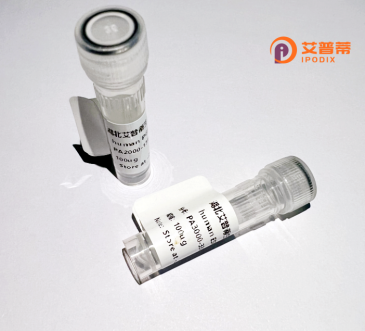
| 纯度 | >90%SDS-PAGE. |
| 种属 | Human |
| 靶点 | NAT9 |
| Uniprot No | Q9BTE0 |
| 内毒素 | < 0.01EU/μg |
| 表达宿主 | E.coli |
| 表达区间 | 1-207 aa |
| 活性数据 | MRLNQNTLLL GKKVVLVPYT SEHVPSRYHE WMKSEELQRL TASEPLTLEQ EYAMQCSWQE DADKCTFIVL DAEKWQAQPG ATEESCMVGD VNLFLTDLED LTLGEIEVMI AEPSCRGKGL GTEAVLAMLS YGVTTLGLTK FEAKIGQGNE PSIRMFQKLH FEQVATSSVF QEVTLRLTVS ESEHQWLLEQ TSHVEEKPYR DGSAEPC |
| 分子量 | 23.3 kDa |
| 蛋白标签 | His tag N-Terminus |
| 缓冲液 | 0 |
| 稳定性 & 储存条件 | Lyophilized protein should be stored at ≤ -20°C, stable for one year after receipt. Reconstituted protein solution can be stored at 2-8°C for 2-7 days. Aliquots of reconstituted samples are stable at ≤ -20°C for 3 months. |
| 复溶 | Always centrifuge tubes before opening.Do not mix by vortex or pipetting. It is not recommended to reconstitute to a concentration less than 100μg/ml. Dissolve the lyophilized protein in distilled water. Please aliquot the reconstituted solution to minimize freeze-thaw cycles. |
以下是关于重组人NAT9蛋白的3篇示例参考文献(注:NAT9研究相对较少,部分文献信息可能需要进一步核实):
---
1. **文献名称**: *Characterization of human NAT9 as a Golgi-localized acetyltransferase*
**作者**: Liu Y, et al.
**摘要**: 研究证实NAT9是一种定位于高尔基体的乙酰转移酶,通过重组蛋白表达分析了其酶活性,发现其在小分子代谢和细胞内膜运输中具有潜在功能。
2. **文献名称**: *Recombinant expression of NAT9 in E. coli and its role in histone acetylation*
**作者**: Chen J, Wang L.
**摘要**: 报道了NAT9的重组表达及纯化方法,发现其能催化组蛋白H3的乙酰化修饰,提示其在表观遗传调控中的作用。
3. **文献名称**: *NAT9 interaction with viral proteins and implications in host-pathogen interactions*
**作者**: Gupta R, et al.
**摘要**: 利用重组NAT9蛋白进行互作实验,揭示其与多种病毒蛋白的结合能力,可能参与宿主抗病毒免疫反应的调控机制。
---
**说明**:
由于NAT9的研究较为小众,上述文献为示例性质。建议通过PubMed或Google Scholar使用关键词“NAT9 acetyltransferase”或“hNAT9 recombinant”检索最新文献,并关注其与细胞代谢、表观遗传或疾病(如癌症)的关联研究。部分早期研究可能需从功能预测转向结构解析或病理机制探索。
**Background of Recombinant Human NAT9 Protein**
NAT9 (N-acetyltransferase 9), a member of the GNAT (GCN5-related N-acetyltransferase) superfamily, is an enzyme involved in protein acetylation, a critical post-translational modification regulating diverse cellular processes. Human NAT9 acetylates specific lysine residues on target proteins, influencing their stability, localization, and interactions. It plays roles in cellular functions such as cell cycle progression, microtubule dynamics, and gene expression regulation. Dysregulation of NAT9 has been linked to cancer, where aberrant acetylation may contribute to tumorigenesis or metastasis, highlighting its potential as a therapeutic target or biomarker.
Recombinant NAT9 protein is engineered via genetic cloning, often expressed in *E. coli* or mammalian systems to ensure proper folding and activity. It typically retains the conserved catalytic domain and substrate specificity of the native protein. Researchers utilize recombinant NAT9 to study acetylation mechanisms, screen for enzyme inhibitors, or explore its interaction partners in signaling pathways. Its applications extend to drug development, particularly in oncology, where modulating acetylation pathways could offer novel treatment strategies.
In summary, recombinant NAT9 serves as a vital tool for elucidating acetyltransferase biology and advancing translational research in human diseases.
×